Soaking in the Past: 8 Storied Onsen of Minamata
Tucked between the sea and the mountains, Minamata is home to two remarkably different hot spring areas—Yunoko and Yunotsuru—each offering its own kind of healing escape. Read on to discover what makes them both worth the journey.
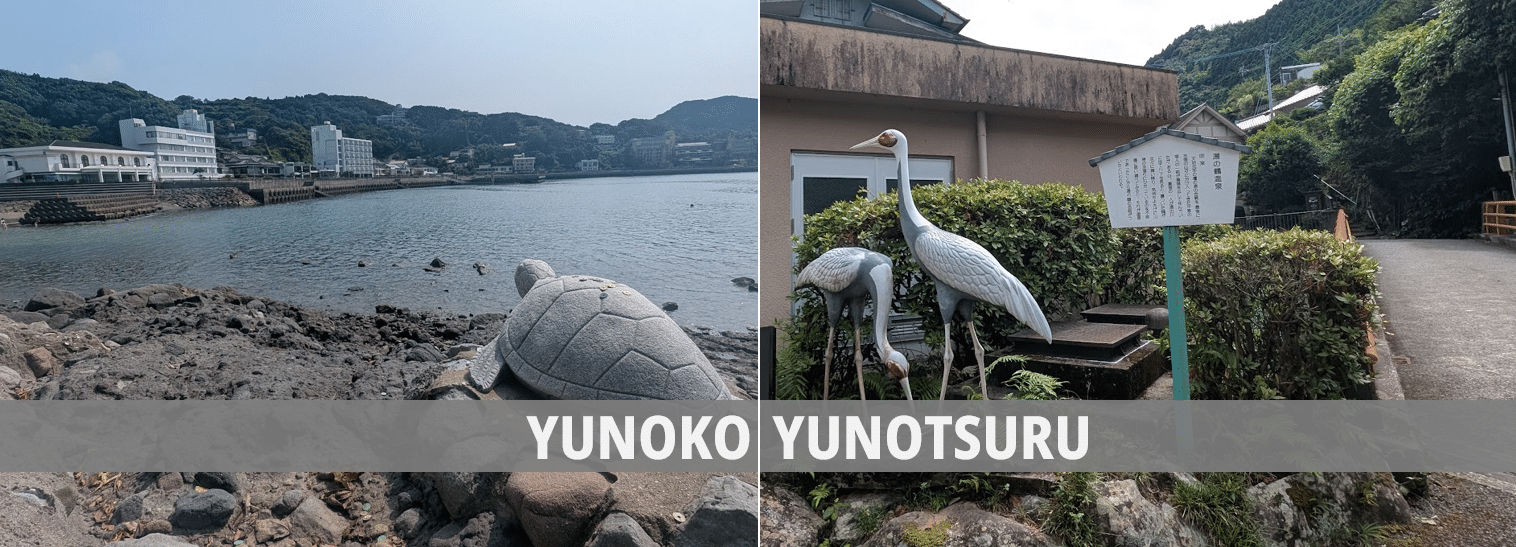
Minamata City, perched at the southern tip of Kumamoto Prefecture near the Kagoshima border, is home to two contrasting yet complementary hot spring areas: Yunoko Onsen (湯の児温泉), set on the sparkling Shiranui Sea, and Yunotsuru Onsen (湯の鶴温泉), nestled among verdant mountain landscapes and waterfalls.
Both places are steeped in local legend—Yunoko said to have been discovered by a healing turtle, and Yunotsuru named after a crane seen recovering in its waters. Celebrated for their soothing springs and connection to nature, these two onsen offer different paths to relaxation.
But alongside the healing waters and scenic beauty, traces of another era remain. Both Yunoko and Yunotsuru are also home to the ruins of once-thriving ryokan and bathhouses—buildings that flourished during Japan’s postwar economic boom and bubble years, but later fell into disuse due to population decline and changing travel patterns. Many still stand, quietly weathering in place—intermixed with modern inns and seaside resorts. Though undeniably tinged with nostalgia and loss, these remnants also offer a glimpse into Japan’s unique modern history and lend an atmosphere that’s both poignant and strangely beautiful.
In the article below, we’ll introduce each area and highlight four bathing spots in each—some perfect for a quick drop-in soak, others ideal for a restorative overnight stay.
History & Geography
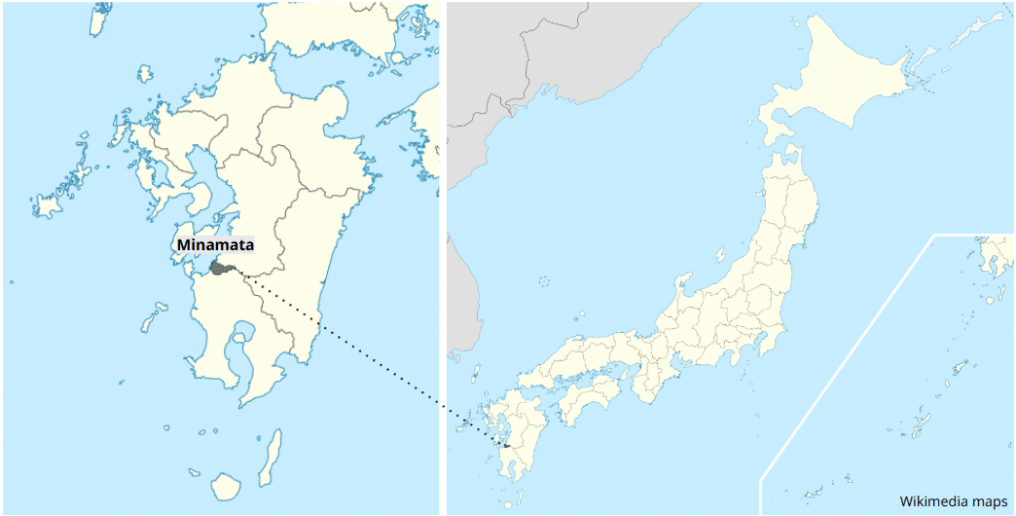
Minamata City is located at the southern edge of Kumamoto Prefecture on the western coast of Kyushu, facing the Yatsushiro Sea and bordering Kagoshima. Despite being part of the same municipality, Yunoko and Yunotsuru Onsen are located in very different settings. Yunoko Onsen lies along the coast about 4 km northwest of Minamata Station, offering wide ocean views and beach access. In contrast, Yunotsuru Onsen is tucked away in the inland mountains, around 9 km southeast of the station, nestled in a quiet valley carved by the Yude River. The two areas are about 30 minutes apart by car, making it easy to experience both seaside and riverside hot springs in a single visit.
Yunoko Onsen
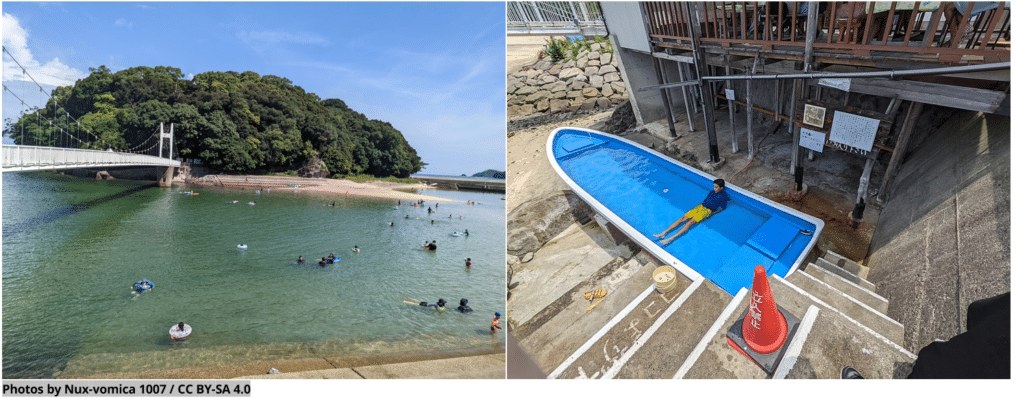
The origin of Yunoko Onsen is explained by locals as follows: according to local legend, a wounded sea turtle discovered a hot spring here, bathed in its waters, and was miraculously healed before returning to the ocean. While the legend remains an important part of local identity, the actual development of the area as a hot spring resort dates to the early 20th century.
Just offshore, a scattering of lush, forested islets gives Yunoko its distinctive coastal character. Linked to the mainland by a small pedestrian bridge, these islands form part of a protected natural area, and at low tide, you can even stroll across the sand to reach them on foot. The wide, gently sloping beach nearby is a favourite with families—kids splash in the shallow sea while parents relax under the open sky, knowing a soothing onsen bath awaits just steps away to wash off the salt water.

For those craving more than a swim on the beach, the Nagisa no Kōban Himetatsu activity centre offers everything from stand-up paddleboarding and sea kayaking to snorkeling and even scuba dives. The waters here are unexpectedly alive—coral beds, tiny seahorses, and schools of colourful fish drift through a surprisingly vibrant undersea world, just beneath the calm surface. It’s a quiet resort, but full of hidden energy.
Yunoko’s modern history is also marked by a fascinating postwar chapter. After World War II, when Allied forces occupied Kumamoto, many soldiers stationed in the region reportedly visited the seaside hot spring resorts frequently, alongside other mainstays of Kumamoto tourism like Mount Aso and Suizenji Park.
👉 See our article about a 1-night, 2-day itinerary featuring an overnight stay at Yunoko Onsen for more ideas on how to enjoy the area.
Yunotsuru Onsen
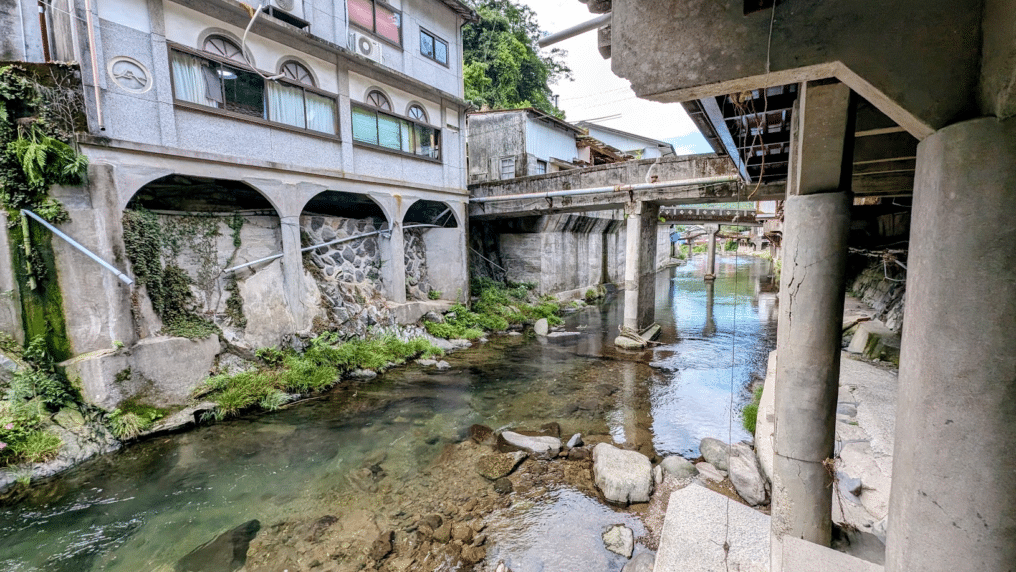
Tucked into the mountains about 9 kilometers southeast of Minamata City, Yunotsuru Onsen sits quietly along the banks of the Yude River. Unlike its seaside counterpart, this hot spring town exudes a quiet, more remote and secluded ambiance, and has long been known as a retreat for healing and restoration.
The origin of Yunotsuru Onsen dates back over 700 years, to the time of the Taira clan. Legend has it that a group of Taira warriors, fleeing from conflict, passed through the valley and witnessed a crane (tsuru) soaking in the hot spring waters to heal an injury. Inspired by the sight, they named the area “Yunotsuru,” meaning “crane of the hot water.” The name stuck—and so did the spring’s reputation as a place of quiet recovery.
Today, Yunotsuru retains much of its old atmosphere. Traditional inns line the narrow riverside road, many of them family-run and passed down through generations. The sound of the river and the sight of mist rising from the baths on a cool morning create a timeless, therapeutic setting that continues to attract those seeking rest in the mountains.
Six Onsen to Experience the Best of Yunoko and Yunotsuru
Yunoko Onsen – Seaside Soaks with a View
1. Shoyokan (昇陽館)
This classic seaside inn, whose name roughly translates to “rising sun inn”, has been serving guests for over a century. With a variety of baths—including a cave-like bath and a cypress tub—Shoyokan is best known for its panoramic open-air bath overlooking the Shiranui Sea, from which you can see the sunrise over the ocean. The mildly alkaline sodium bicarbonate spring is excellent for skin health, and the gentle sea breeze enhances the feeling of release.
- Type: Overnight guests and drop-ins (drop-in use may be closed for various reasons, best to call and check beforehand)
- Drop-in hours: 12:00–17:00
- Fee: ¥700 (adults), ¥350 (children)
- Official website: https://www.shoyokan.com/
- Google Maps: https://maps.app.goo.gl/joLDAYDxfNrBbVTP8
A popular choice for those wanting a traditional ryokan experience with a full seafood kaiseki dinner and a soak under the setting sun.
2. Umi to Yuyake (海と夕やけ)
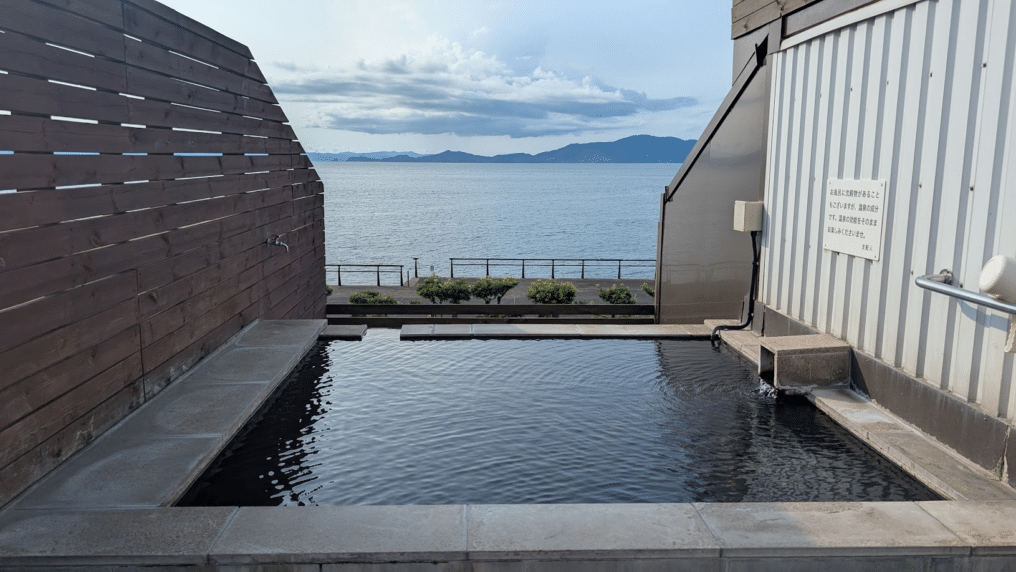
This resort delivers exactly what its name promises: “The Sea and the Sunset.” Every room and bath faces the water, offering stunning views of the Shiranui Sea. The hotel’s natural hot spring baths—especially the rooftop open-air bath—are prime spots to watch the sky turn gold.
- Bath access: Overnight guests and drop-ins (drop-in use may be closed for various reasons, best to call and check beforehand)
- Drop-in hours: 14:00–18:00
- Fee: ¥800 (adults), ¥400 (children)
- Official Website: https://www.umitoyuyake.com/
- Google Maps: https://maps.app.goo.gl/LWjPxvPjdSMxaVKq8
The facility’s all you can eat dinner buffet features local sashimi and attracts couples and families looking for a relaxing, well-equipped base to unwind.
3. Saito Ryokan (齊藤旅館)
Run by a local fishing family, Saito Ryokan is a small, friendly inn with a personal touch. Guests can try one of several unique private baths, including a mineral-encrusted cave-style bath and even a tub made from a repurposed fishing boat.
- Type: Overnight stays & day-use
- Day-use hours: 12:00–21:00 (closed Mondays)
- Fee: ¥500
- Reservation: Walk-ins welcome
- Google Maps: https://www.google.com/maps?cid=5700472167039704669
Simple, warm, and authentic—perfect for travellers seeking a no-frills soak in a truly local setting.
4. Nakamura Onsen (中村温泉)
In contrast to the many other type of nearby inns and bath houses, Nakamura Onsen specialises in private baths where small groups or families (or even individuals) can rent their own small private bathing area for an hour at a time, and not have to worry about sharing the space with strangers. Nakamura Onsen offers 100% free-flowing, saline spring water known for its gentle skin benefits and healing properties.
Usage Info:
- Type: Day-use family baths only
- Hours: 10:00 am – 10:00 pm; no fixed holidays
- Fee: ¥1,000 per group (up to 5 people)
- Google Maps: https://www.google.com/maps?cid=2106387959714792868
Yunotsuru Onsen – Hidden Healing in the Hills
5. Hotaru no Yu (ほたるの湯)
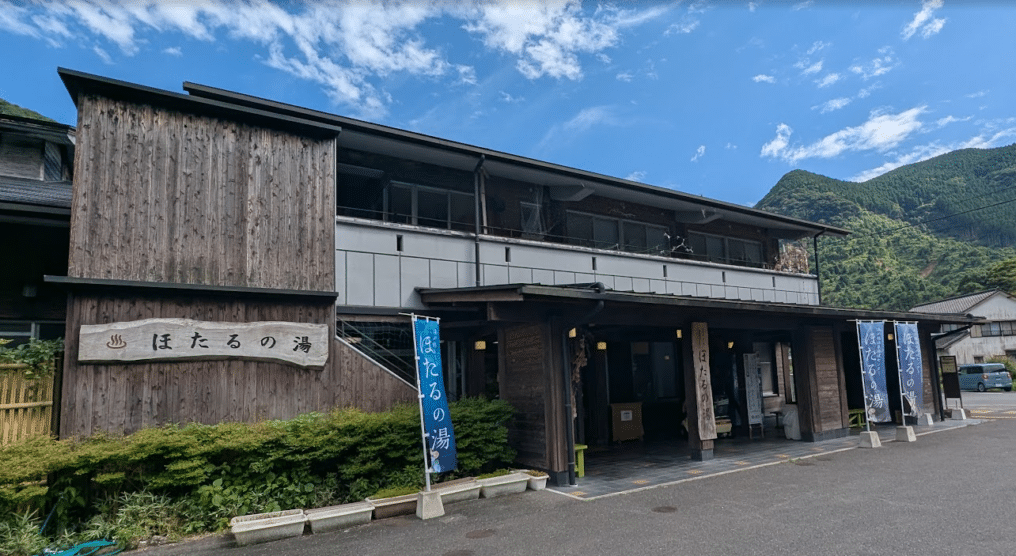
This city-run facility is beloved for its affordability and welcoming atmosphere. The wooden hinoki cypress tubs are filled with soft sulfuric water from a local source. The name literally means something to the effect of “Bath of the Fireflies”, referring to the fireflies that dot the riverside in the early summer evenings.
- Type: Day-use only (not a ryokan)
- Hours: 10:00–20:00 (closed Mondays)
- Fee: ¥250
- Reservation: Not required
- Google Maps: https://www.google.com/maps?cid=14324451842421821141
6. Kiku-no-Yu (きくの湯)
This no-frills public bathhouse has been serving locals for decades—and at only ¥100 per visit, it’s an incredible deal. Inside, the clear carbonated waters bubble directly from the source under the floor, clinging to your skin in soft bubbles. Look for the honesty box at the door to leave your coin.
- Type: Day-use only
- Hours: 8:30–18:00
- Fee: ¥100 (¥50 for children)
- Reservation: Not available (pay at the door)
- Official Website:
- Google Maps: https://www.google.com/maps?cid=878325059727929285
A must for onsen purists and lovers of Showa-era Japan—just bring your own soap and towel.
7. TojiyA (旅宿とうじや)
TojiyA is a unique accommodation in Yunotsuru Onsen – it’s an onsen guesthouse that has repurposed a 170-year-old traditional inn. The name “TojiyA” itself is a play on the word “toji” (湯治), meaning therapeutic hot spring retreat, combined with “ya” (宿) meaning inn. This reflects the inn’s historical role: Yunotsuru Onsen has long been a place where people would come for extended stays to heal in the waters. TojiyA’s building was once a long-established ryokan, and after a complete renovation in 2017, it reopened as a casual guesthouse while preserving its vintage charm. Given that it is a guesthouse with a rather reasonable price point per night, it is great for longer term stays to really detox and unwind while having access to the bath 24 hours a day.
- Bath access: Overnight guests and drop-ins
- Drop-in hours: 3:00 pm – 10:00 pm
- Overnight stays: From 5000 yen/night
- Fee: ¥300 (adults), ¥150 (children)
- Official Website: www.tojiya.jp
- Google Maps: https://maps.app.goo.gl/2mD6ykqWX9Mz4uey8
8. Asahi-so (あさひ荘)
A mid-century wooden inn (about 48 years old) nestled in the forested valley. The clear, slightly alkaline simple sulfur spring (pH ~8.5) produces a silky soft feeling on the skin. The facility includes a large indoor bath, rock bath, and scenic open-air bath overlooking the valley.
- Type: Overnight stays and drop-ins
- Drop-ins hours: Approx. 11:00–15:00; may be closed to drop-ins depending on the number of overnight guests, so best to call in advance and confirm
- Fee: ¥500 (adults), ¥300 (children)
- Official Website: www.asahisou.jp
- Google Maps: https://maps.app.goo.gl/yN6rKi2dPPRdHaei8
🧭 Choosing Your Experience
Whether you’re drawn to the shimmering coastline of Yunoko or the quiet river valley of Yunotsuru, Minamata’s twin hot spring towns offer a rare opportunity to slow down and experience a different rhythm of life. From sea-facing baths to centuries-old mountain retreats, each destination carries its own sense of place and history. For a fuller picture of what Minamata has to offer, consider visiting both areas and discovering how the contrasts between ocean and mountains complement one another.
👉 See our article about a 1-night, 2-day itinerary featuring an overnight stay at Yunoko Onsen for more ideas on how to enjoy the area.
🗺️ View the map of all locations mentioned in this article:



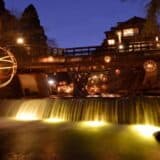

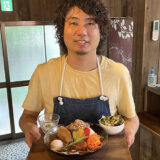

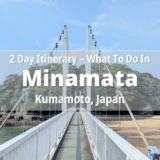
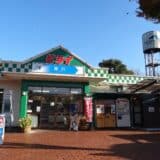
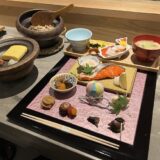

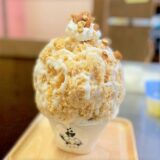

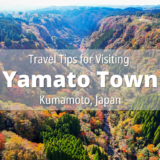
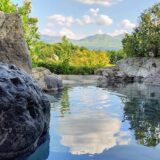

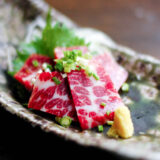
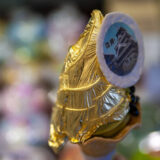
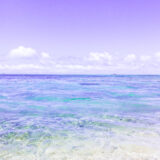
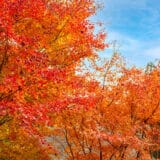
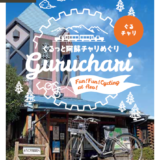


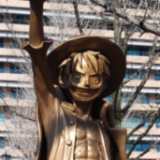

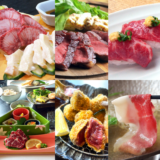

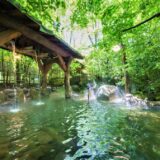

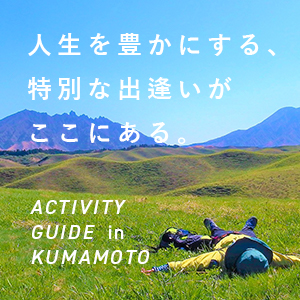

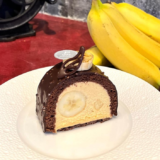
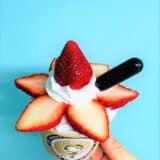

[…] ngs in a quiet riverbed surrounded by mountains, Minamata has that too. Check out our article “Soaking in the Past: 8 Storied Onsen of Minamata” comparing Yunoko Onsen with Yunotsuru Onsen, which dives into the history of both areas and h […]